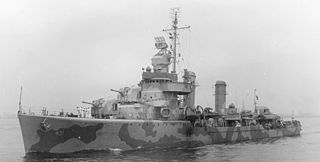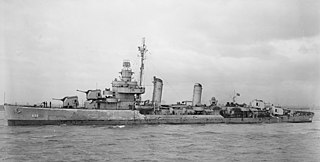
USS Whipple, a Clemson-class destroyer was the second ship of the United States Navy named in honor of Captain Abraham Whipple (1733–1819), who served in the Continental Navy.

USS Abbot (DD-629) was a Fletcher-class destroyer in the service of the United States Navy. She was the second Navy ship named after Commodore Joel Abbot (1793–1855).

USS Picking (DD-685), a Fletcher-class destroyer, was a ship of the United States Navy named for Sherwood Picking (1890–1941), a submarine commander during World War I.
USS Dallas (DD-199) was a Clemson-class destroyer in the United States Navy during World War II. She was the second ship named for Captain Alexander J. Dallas, and was later renamed Alexander Dallas.

USS Anthony (DD-515), a Fletcher-class destroyer, was the second ship of the United States Navy to be named for Marine Sergeant Major William Anthony (1853–1899).

USS Livermore (DD-429), a Gleaves-class destroyer, was the 1st ship of the United States Navy to be named for Samuel Livermore, the first naval chaplain to be honored with a ship in his name.

USS Plunkett (DD-431), a Gleaves-class destroyer, is the only ship of the United States Navy to be named for Rear Admiral Charles Peshall Plunkett.

USS Woolsey (DD-437), a Gleaves-class destroyer, was the second ship to be named Woolsey in the United States Navy. It is the first to be named for both Commodore Melancthon Brooks Woolsey and his father Commodore Melancthon Taylor Woolsey.

USS Rodman (DD-456/DMS-21), a Gleaves-class destroyer, is the first ship of the United States Navy to be named for Admiral Hugh Rodman.

USS Macomb (DD-458/DMS-23) was a Gleaves-class destroyer of the United States Navy, named for Commodore William H. Macomb (1819–1872) and Rear Admiral David B. Macomb (1827–1911).

USS Knight (DD-633), a Gleaves-class destroyer, is the only ship of the United States Navy to be named for Admiral Austin M. Knight.

USS Warrington (DD-383) was a Somers-class destroyer, laid down on 10 October 1935 at Kearny, New Jersey, by the Federal Shipbuilding and Drydock Company; launched on 15 May 1937; sponsored by Miss Katherine Taft Chubb; and commissioned at the New York Navy Yard on 9 February 1938.

USS Walton (DE-361) was a John C. Butler-class destroyer escort in the United States Navy. It was named after Merrit Cecil Walton, a Marine Corps platoon sergeant with the U.S. 1st Marine Division, who died on Gavutu during the Battle of Guadalcanal and was posthumously awarded the Navy Cross for "extraordinary heroism".

USS Tatum (DE-789/APD-81) was a Buckley-class destroyer escort in service with the United States Navy from 1944 to 1946. She was scrapped in 1960.

USS Triumph (AM-323) was a World War II Auk-class minesweeper of the United States Navy.

USS Speed (AM-116) was an Auk-class minesweeper acquired by the United States Navy for the dangerous task of removing mines from minefields laid in the water to prevent ships from passing.

USS Trumpeter (DE-180) was a Cannon-class destroyer escort in service with the United States Navy from 1943 to 1947. She was sold for scrap in 1974.

USS Tills (DE-748) was a Cannon-class destroyer escort in service with the United States Navy from 1944 to 1946 and from 1950 to 1968. She was sunk as a target in 1969.

USS Tomich (DE-242) was an Edsall-class destroyer escort in service with the United States Navy from 1943 to 1946. She was scrapped in 1974.

USS Weber (DE-675/APD-75) was a Buckley-class destroyer escort of the United States Navy, named in honor of Ensign Frederick T. Weber (1916–1942), a naval aviator who was posthumously awarded the Navy Cross for heroism during the Battle of Midway.





















